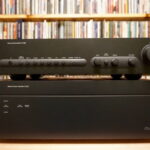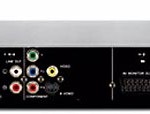BLACK LEVEL
LCD and plasma TV manufacturers are proud of announcing their latest improvements in Contrast Ratio, and rightly so: the contrast of a display–that is, the difference between the “blackest” blacks and the “whitest” whites–is one of the most important factors in achieving a realistic picture that accurately conveys all the information present in a video signal. Half of that equation, the Black Level, will be calibrated using the Brightness control on your TV.
Black Level is optimized using a PLUGE pattern (‘PLUGE’ stands for Picture Line Up Generation Equipment), which regardless of your calibration disc will consist of a black-and-white screen divided into various shades of grays, running all the way down to black. A crucial step here is to make sure your DVD player itself is configured properly; the PLUGE pattern actually contains some areas which are below black, and you should make sure your DVD player is set up to send “below black” signals by enabling the option in the setup menu of your DVD player. Again, consult your manual if you can’t find the setting: you’re looking for “send below-black signals,” “0 IRE Signals,” or something similar.
The PLUGE test and Brightness calibration will basically take the form of lowering the TV’s Brightness control until a black area of the screen (leftmost and rightmost black bars on Digital Video Essentials, dropshadow of the THX logo on the THX Optimizer) disappears from view, then slowly raising the Brightness until it is just visible. This adjustment assures that anything intended to be black on your DVD will be completely black, while still allowing you to see every detail in dark or shadowy scenes.
WHITE LEVEL
Closely related to the Black Level, but at the other end of the spectrum, is the White Level. Again, it’s common for TVs to come out of the box with the Contrast or Picture control set far too high, which results in whites and bright shades “blooming,” or bleeding together: think of the brightest shades in a scene looking as if they were “colored outside the lines.” To adjust the White Level of your LCD TV, you will use a test pattern that features a pure white area contrasted with a 95% or near white area. The setup will differ according to which calibration disc you use, but the basic idea is the same. There are two things you’re looking for in this adjustment: 1) You want to be able to distinguish the slightly darker box from the pure white box. This will ensure that you get all the fine details in a bright scene–like faint shadows or texture in snow, or the creases in an actor’s white shirt. 2) You also want to ensure that the whites aren’t set so high that the whites “bloom” into surrounding areas; this will greatly reduce the contrast and sharpness of your picture as colors bleed into one another.
To make the adjustment, first raise the Contrast control (sometimes called Picture) until the darker white area disappears into the pure white. Then, gradually decrease the Contrast until the box is visible again. One click may make the difference, so take your time and make careful adjustments. Finally, once you have the White Level where you want it, closely examine the edges of the pure white area where it borders the black background. Is it a sharp line, or does the white area blur or smear into the black? If it’s a sharp line, you’re in business. If the white area “blooms” into the black, back off the Contrast a notch or two until the border is sharply-defined.







